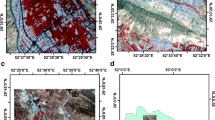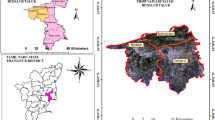Abstract
Land degradation is one of the most critical environmental challenges affected by the change of the land use land cover in the last few decades. Land degradation has a negative impact on the livelihood and food security worldwide. The annual cost of land degradation caused by land use land cover change is estimated at 231 billion US dollars. It should be noticed that recent droughts caused by global climate change and, on the other hand, population growth have increased the rate of urbanization in Iran. In this study, to monitor the recent urbanization, several advanced and state-of-the-art classification algorithms, including small and large neural networks, support vector machine, and the genetic algorithm multi-layer perceptron (GAMLP) model, are developed in R and MATLAB programming languages for land use land cover modeling in the years 1990 and 2018 of the Shiraz City. For the year 1990, the SVM algorithm has the best performance in terms of overall accuracy and kappa indices with the values of 93.55 and 89.22, respectively. The SVM classifier has better performance for the year 2018 as well, with values of 98.37 and 95.76 for the overall accuracy and kappa indices. The developed GAMLP model has better performance over the other two small and deep neural network classifiers with the values of 92.88 and 89.09 for the year 1990 and values of 97.38 and 93.12 for overall accuracy and kappa indices for the year 2018. Based on the results, built up areas have increased in the study area where the vegetation regions decrease from 1990 to 2018.









Similar content being viewed by others
References
AbdelRahman MAE, Shalaby A, Aboelsoud MH, Moghanm FS (2018) GIS spatial model based for determining actual land degradation status in Kafr El-Sheikh Governorate, North Nile Delta. Model Earth Syst Environ 4(1):359–372
Afifi AA, El Semary MA (2018) The impact of long term cropping and land use change on the degradation of heavy clay soils in the Nile Delta, Egypt. Model Earth Syst Environ 4(2):805–814
Bégué A, Arvor D, Bellón B, Betbeder J, de Abelleyra D, Ferraz RPD, Lebourgeois V, Lelong C, Simões M, Verón SR (2018) Remote sensing and cropping practices: a review. Remote Sens 10:99
Belward AS, Skøien JO (2015) Who launched what, when and why; trends in global land-cover observation capacity from civilian earth observation satellites. ISPRS J Photogramm Remote Sens 103:115–128
Chang C, Lo S, Yu S (2006) The parameter optimization in the inverse distance method by genetic algorithm for estimating precipitation. Environ Monit Assess 117:145–155
Chavez PS (1996) Image-based atmospheric corrections—revisited and improved. Photogrammetric Engineering and Remote Sensing 62(9):1025–1036
Chen Y, Chen J, Hsieh S, Ni P (2009) The application of remote sensing technology to the interpretation of land use for rainfall-induced landslides based on genetic algorithms and artificial neural networks. IEEE J Sel Top Appl Earth Obs Remote Sens 2:87–95
Congedo L, Munafò M (2014) Climate change vulnerability in Southern African cities. https://doi.org/10.1007/978-3-319-00672-7
Fayaz A, Shafiq MU, Singh H, Ahmed P (2020) Assessment of spatiotemporal changes in land use/land cover of North Kashmir Himalayas from 1992 to 2018. Model Earth Syst Environ 6(2):1189–1200
Gashaw T, Behaylu A, Tilahun A, Fentahun T (2014) Population growth nexus land degradation in Ethiopia. Population 4(11):54
Ghosh S (2019) A city growth and land-use/land-cover change: a case study of Bhopal, India. Model Earth Syst Environ 5(4):1569–1578
Goodin DG, Anibas KL, Bezymennyi M (2015) Mapping land cover and land use from object-based classification: an example from a complex agricultural landscape. Int J Remote Sens 36(18):4702–4723
Harris R, Baumann I (2015) Open data policies and satellite earth observation. Sp Policy 32:44–53
Hasegawa H, Naito T, Arimura M, Tamura T (2013) Hybrid model of random forests and genetic algorithms for commute mode choice analysis. In: Proceedings of the eastern Asia society for transportation studies, vol 9
Jamali A (2019a) Evaluation and comparison of eight machine learning models in land use/land cover mapping using Landsat 8 OLI: a case study of the northern region of Iran. SN Appl Sci 1:1448
Jamali A (2019b) A fit-for algorithm for environmental monitoring based on maximum likelihood, support vector machine and random forest. Int Arch Photogramm Remote Sens Spatial Inf Sci XLII-3/W7:25–32. https://doi.org/10.5194/isprs-archives-XLII-3-W7-25-2019
Jamali A, Rahman AA (2019) SENTINEL-1 image classification for city extraction based on the support vector machine and random forest algorithms. Int Arch Photogramm Remote Sens Spat Inf Sci 42:297–302
Kayet N, Pathak K, Chakrabarty A, Sahoo S (2016) Spatial impact of land use/land cover change on surface temperature distribution in Saranda Forest, Jharkhand. Model Earth Syst Environ 2(3):127
Kumar BP, Babu KR, Rajasekhar M et al (2020) Identification of land degradation hotspots in semiarid region of Anantapur district, Southern India, using geospatial modeling approaches. Model Earth Syst Environ. https://doi.org/10.1007/s40808-020-00794-x
Li W, Haohuan F, Le Yu P, Gong DF, Congcong L, Clinton N (2016) Stacked autoencoder-based deep learning for remote-sensing image classification: a case study of african land-cover mapping. Int J Remote Sens 37(23):5632–5646
Li W, Haohuan F, Le Y, Cracknell A (2017) Deep learning based oil palm tree detection and counting for high-resolution remote sensing images. Remote Sens 9:1
Mansaray LR, Wang F, Huang J, Yang L, Kanu AS (2019) Accuracies of support vector machine and random forest in rice mapping with Sentinel-1A, Landsat-8 and Sentinel-2A datasets. Geocarto Int 35:1–21
Mas JF, Flores JJ (2008) The application of artificial neural networks to the analysis of remotely sensed data. Int J Remote Sens 29(3):617–663
Moayedi H, Jamali A, Gibril MBA, Kok Foong L, Bahiraei M (2020) Evaluation of tree-base data mining algorithms in land used/land cover mapping in a semi-arid environment through Landsat 8 OLI image; Shiraz, Iran. Geom Nat Hazards Risk 11(1):724–741
Mohanty SP, Hughes DP, Marcel S (2016) Using deep learning for image-based plant disease detection. Front Plant Sci 7:1419
Mountrakis G, Jungho I, Ogole C (2011) Support vector machines in remote sensing: a review. ISPRS J Photogramm Remote Sens 66(3):247–259
Nasehi S, Imanpour Namin A, Salehi E (2019) Simulation of land cover changes in urban area using CA-MARKOV model (case study: zone 2 in Tehran, Iran). Model Earth Syst Environ 5(1):193–202
Nkonya E, Anderson W, Kato E, Koo J, Mirzabaev A, von Braun J, Meyer S (2016) Global cost of land degradation. Economics of land degradation and improvement—a global assessment for sustainable development. Springer, Cham, pp 117–165
Omran E-SE (2016) Early warning information system for land degradation hazards in New Suez Canal region, Egypt. Model Earth Syst Environ 2(2):103
Prabhakar A, Tiwari H (2015) Land use and land cover effect on groundwater storage. Model Earth Syst Environ 1(4):45
Richards JA, Richards JA (1999) Remote sensing digital image analysis, vol 3, pp 10–38
Rouse Junior JW, Hass RH, Schell JA, Deering DW (1974) Monitoring vegetation systems in the Great Plains with ERTS. In: Third earth resources technology satellite-1 symposium, pp 309–317. https://www.ntrs.nasa.gov/archive/nasa/casi.ntrs.nasa.gov/19740022614.pdf. Accessed 17 June 2020
Samanta S, Paul SK (2016) Geospatial analysis of shoreline and land use/land cover changes through remote sensing and GIS techniques. Model Earth Syst Environ 2(3):108
Shao Y, Lunetta RS (2012) Comparison of support vector machine, neural network, and CART algorithms for the land-cover classification using limited training data points. ISPRS J Photogramm Remote Sens 70:78–87
Wubie MA, Assen M (2020) Effects of land cover changes and slope gradient on soil quality in the Gumara watershed, Lake Tana basin of North-West Ethiopia. Model Earth Syst Environ 6(1):85–97
Author information
Authors and Affiliations
Corresponding author
Ethics declarations
Conflict of interest
The authors declare that they have no conflict of interest.
Additional information
Publisher's Note
Springer Nature remains neutral with regard to jurisdictional claims in published maps and institutional affiliations.
Rights and permissions
About this article
Cite this article
Jamali, A. Land use land cover modeling using optimized machine learning classifiers: a case study of Shiraz, Iran. Model. Earth Syst. Environ. 7, 1539–1550 (2021). https://doi.org/10.1007/s40808-020-00859-x
Received:
Accepted:
Published:
Issue Date:
DOI: https://doi.org/10.1007/s40808-020-00859-x




